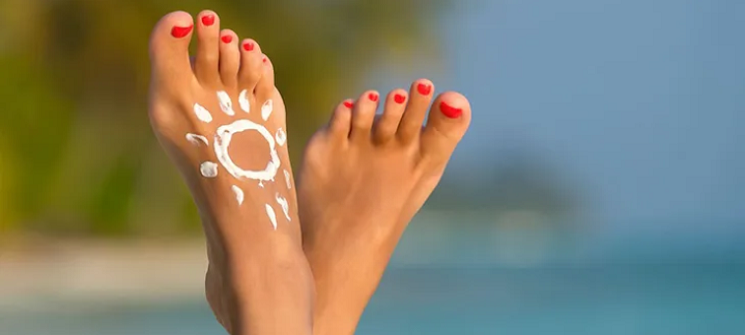Summer is here – but that might not be great news if you live in dread at the thought of having to expose your feet.
Whether your feet just need a bit of TLC and pampering, or a stubborn foot condition is causing you bother, there’s no need to suffer in silence.
Foot conditions might be embarrassing – but they are generally common, and treatments are available.

Sometimes, this might mean visiting a specialist for some expert advice, so you can sort those troubles once and for all.
Here, podiatrist Tony Gavin, founder of Osgo, talks us through some of the common foot issues he regularly treats.
1. Bunions

Bunions are one of the most common forefoot deformities – and they can be very painful.
“A bunion, or hallux valgus, is a change to the bone structure at the base of the big toe. It’s an enlargement of the joint and a change in direction of where the big toe ‘points’, towards the second toe,” explains Mr Gavin. This leads to an increase in the size of the joint, and often the formation of an overlying ‘bursa’ (a fluid-filled sac between the joint and the skin), which may be red and swollen. “It’s basically the body’s way of protecting the joint,” notes Mr Gavin.

“Managing any pain is a key part of a podiatrist’s role when treating bunions,” Mr Gavin continues. “The first port of call is to ensure that there is adequate room in any footwear, in some circumstances foot orthotics (tailor-made insoles, padding and arch supports) can help.”
However, in many cases, surgery to correct the bunion might be needed. If bunions are causing you problems, see a podiatrist to discuss referrals.
2. Fungal nail infections

Crusty, thickened yellow toenails are a tell-tale sign of a fungal nail infection – and it’s important to get them checked out and treated quickly, as the infection can spread and be notoriously stubborn. “Fungal nails cause dramatic visual changes, which can be unsightly,” says Mr Gavin. “They can make the nail change colour, thicken, and break more easily.”
They can also cause more pressure on the end of the toe and become painful. “As the fungal infection progresses, they can produce a very distinct odour too,” adds Mr Gavin.
The good news is, fungal nail infections are treatable – although more severe infections may take a while to disappear completely. “There are a variety of treatments, but success depends on an appropriate plan. Medication needs to act on the affected areas, which can be difficult with topical preparations. A podiatrist may thin down a fungal nail or introduce very small holes into the nail and apply an anti-fungal medication,” says Mr Gavin.
3. Corns and calluses

“Perhaps the most common reason that people seek treatment from a podiatrist is to deal with calluses or corns,” says Mr Gavin, “as they can be very painful and make walking difficult.”
Pressure plays a big part in the formation of calluses and corns, which often look like very hard, raised areas of skin. “Intermittent compressive forces (from walking) cause a response from the skin to produce callosities,” Mr Gavin explains. This layer can at first be protective and an advantage to the foot, but they can very quickly become painful if they get worse.
A corn, meanwhile, is a small, usually conical structure that forms from pressure. “It’s formed within the skin, is very hard and can cause a lot of pain,” says Mr Gavin. “Common locations for corns are the tops of toes, or underneath the metatarsal heads on the plantar aspect of the foot [near the ball of your foot]. A podiatrist can remove a corn in a painless procedure, and often prevent them returning by using orthotics or advising footwear changes.”
4. Athlete’s foot
Itchy, sore and easy to catch, Athlete’s foot is relatively common. “It’s a fungal infection of the skin, usually seen between the toes or on the sole of the foot,” says Mr Gavin. “Athlete’s foot can be very uncomfortable at its worst, or mildly itchy at its least severe. It often causes skin to flake, peel or even split too.
“Itching the skin increases the likelihood of the skin splitting, which in turn can lead to a secondary infection. Split skin can also be very painful to walk on.”

Mr Gavin explains that the infection is caused by dermatophytes, fungi that thrive in the conditions we place our feet in every day: “The environment inside of shoes is dark, warm and moist, which just so happens to be the perfect place for a fungal infection to thrive.”
Luckily, treatment is usually quite effective. “Topical preparations [creams] are usually very successful under the advice of a podiatrist,” says Mr Gavin. “Ensuring your socks and shoes are changed frequently can also reduce the risk of the infection returning.”
5. Verrucas
Verrucae, or verrucas, is a common complaint among children and adults. “A verruca is a small, benign, skin lesion – approximately 1cm in diameter – commonly found on the bottom of the foot.”
Over-the-counter treatments sometimes work, but due to the nature of the virus, some outbreaks can be very stubborn. If this is the case, a podiatrist may offer additional treatments, such as caustics, needling or microwave treatments to help get them under control.
6. Foot odour
“Foot odour is often linked to excessive sweating (hyperhidrosis), which creates an environment where bacteria can thrive. There can be a number of causes for sweating, which may be related to materials in hosiery or shoes, activities, or even a systemic cause,” says Mr Gavin.
If overpowering foot odour is becoming a problem, a podiatrist can advise on the best course of action to reduce the bacterial load and reduce sweating. This may include anti-bacterial medication, a simple change in sock materials and, in some cases, footwear changes or orthotics.
What next?
Feet can often be a source of embarrassment, but if you’re suffering with any of the above issues, you don’t have to resign yourself to a summer stuck in trainers or closed-toe shoes.
Typically, you don’t need a referral to see a podiatrist, you can make an appointment with a local one. However, you might need a referral to see a podiatrist if you fall under a medical concession scheme such as the Department of Veteran Affairs or Worker’s Compensation.
Have you ever suffered from a foot condition? Did you go to see a specialist or sort it out at home?
– With PA
If you enjoy our content, don’t keep it to yourself. Share our free eNews with your friends and encourage them to sign up.
Related articles:
https://www.yourlifechoices.com.au/health/your-health/prevention/keeping-your-feet-healthy-and-pain-free
https://www.yourlifechoices.com.au/health/your-health/what-your-feet-may-be-saying
https://www.yourlifechoices.com.au/lifestyle/how-to-make-your-feet-feel-and-look-their-best
Disclaimer: This article contains general information about health issues and is not advice. For health advice, consult your medical practitioner.

